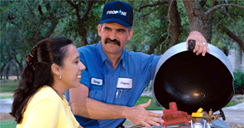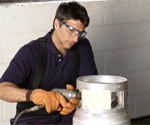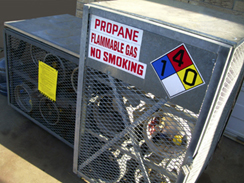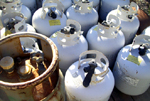

- Extinguish all open flames
- Vacate the area
- Don't use any electric device
- Close the gas shutoff valve
(righty-tighty) - Call your propane service provider
- Do not return to the area until you get the okay from a qualified propane service provider.|
See More




Propane Cylinder Filling
Many people choose to have their propane cylinders filled at propane refueling stations rather than exchanging them at an available location. Cylinders that propane dealers most often fill are the 20 pound bottles commonly used for gas grills. Because there are different types and sizes of cylinders, the filling process is not always the same as requirements vary by cylinder. This section will hopefully answer questions people may have when taking their bottle to be filled.
Bottle filling policies vary by company. Some companies charge by the cylinder while others charge by the gallon. Charging by the cylinder is a common industry practice so know in advance that consumers may be charged the full amount even if the bottle isn't completely empty.
Visual Cylinder Inspection
All cylinders will undergo a simple visual inspection prior to being filled. This exterior inspection is performed on all bottles regardless of size or type. The bottle filler is looking for the following things:
1.
Damage to the cylinders exterior including dents, bulges or cracks on the container's surface
2.
Excessive rust or pitting on the cylinder, particularly on the bottom of the bottle
3.
Absence and condition of a cylinder foot ring, cylinder collar, or valve cover
4.
The date the cylinder was manufactured or last recertified
5.
Required cylinder markings and readability
6.
OPD valve (if required)
7.
See Propane Cylinder Requirements for additional information
If the bottle filler is unable to fill the bottle because it fails the visual inspection, it is strictly for safety, regulatory compliance and in the consumers best interest. Remember that a propane company doesn't make money by turning customers away and if one company denies filling the cylinder, taking it to another LP Gas company for a second opinion will likely result in a second denial. See pictures of damaged and condemned propane cylinders.
Cylinders Filled By Weight
Following the visual exterior bottle inspection, the bottle filler will look for two other things prior to hooking up the fill hose with the cylinder on the scale. These two things are the water capacity and tare weight. The water capacity is how much water the propane bottle will hold in pounds. The "WC" stamped on the bottle followed by a number such as "47.6" means the bottle will hold 47.6 pounds of water. The tare weight (empty weight) indicated by a "TW" is also followed by a number such as "18" meaning the bottle weighs 18 pounds when empty. The numbers here would likely be found on a five gallon propane bottle (also known as a 20 pound cylinder) used for a barbeque grill.
The bottle filling station will generally have a cylinder filling chart that converts water capacity (WC) to pounds of propane that the filler will refer to before filling the bottle. The chart will show that 47.6 pounds of water converts to 20 pounds of propane. In other words, a propane bottle that will hold 47.6 pounds of water will hold 20 pounds of propane. This indicates that the scale needs to be set a little over 38 pounds (20 lbs + 18 lbs = 38 lbs) to obtain the weight of the bottle when it reaches its allowable capacity.
After the scale is set and the hose end nozzle is hooked up to the cylinder, the attendant may open the bleeder valve, reset the meter and begin pumping propane into the bottle. The attendant will stop the pump once:
1.
The bleeder valve starts to spew liquid
2.
The scale indicates the cylinder has reached its legal filling capacity
3.
The OPD valve stops the flow of propane into the cylinder (if equipped with an OPD valve)
Some companies will load your cylinder in your vehicle for you once the cylinder has been filled while some companies are not allowed to do this due to liability reasons. So don't be offended if you have to load your own cylinder. The bottle filling attendant is just following the rules.
Cylinders Filled By Bleeder Valve
Cylinders filled by fixed liquid level gauge, such as forklift cylinders are not required to be filled by weight. They are subject to visual inspections and recertification requirements like all cylinders but are not filled using a scale. Some companies may use a scale but the standard practice is to use the fixed liquid level gauge (bleeder valve). Once the hose end nozzle is hooked up to the cylinder and the pump is turned on, the bottle filler will wait for liquid to spew out and turn off the pump. The bleeder valve will be closed and the hose will be disconnected. The bleeder valve is the indicator letting the attendant know when the cylinder is full. He's not inadvertently letting propane out of your cylinder but rather following the rules and abiding by the law governing cylinder filling.
